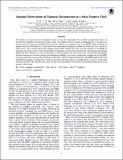Files in this item
Imaging observations of magnetic reconnection in a solar eruptive flare
Item metadata
| dc.contributor.author | Li, Y. | |
| dc.contributor.author | Sun, X. | |
| dc.contributor.author | Ding, M. D. | |
| dc.contributor.author | Qiu, J. | |
| dc.contributor.author | Priest, E. R. | |
| dc.date.accessioned | 2017-03-17T17:30:12Z | |
| dc.date.available | 2017-03-17T17:30:12Z | |
| dc.date.issued | 2017-01-31 | |
| dc.identifier | 249407642 | |
| dc.identifier | 4f62d461-6662-4ed5-9594-ca6b91f9e4b0 | |
| dc.identifier | 85012014200 | |
| dc.identifier | 000401145700006 | |
| dc.identifier.citation | Li , Y , Sun , X , Ding , M D , Qiu , J & Priest , E R 2017 , ' Imaging observations of magnetic reconnection in a solar eruptive flare ' , Astrophysical Journal , vol. 835 , no. 2 , 190 . https://doi.org/10.3847/1538-4357/835/2/190 | en |
| dc.identifier.issn | 0004-637X | |
| dc.identifier.other | ORCID: /0000-0003-3621-6690/work/74117702 | |
| dc.identifier.uri | https://hdl.handle.net/10023/10486 | |
| dc.description.abstract | Solar flares are among the most energetic events in the solar atmosphere. It is widely accepted that flares are powered by magnetic reconnection in the corona. An eruptive flare is usually accompanied by a coronal mass ejection, both of which are probably driven by the eruption of a magnetic flux rope (MFR). Here we report an eruptive flare on 2016 March 23 observed by the Atmospheric Imaging Assembly on board the Solar Dynamics Observatory. The extreme-ultraviolet imaging observations exhibit the clear rise and eruption of an MFR. In particular, the observations reveal solid evidence of magnetic reconnection from both the corona and chromosphere during the flare. Moreover, weak reconnection is observed before the start of the flare. We find that the preflare weak reconnection is of tether-cutting type and helps the MFR to rise slowly. Induced by a further rise of the MFR, strong reconnection occurs in the rise phases of the flare, which is temporally related to the MFR eruption. We also find that the magnetic reconnection is more of 3D-type in the early phase, as manifested in a strong-to-weak shear transition in flare loops, and becomes more 2D-like in the later phase, as shown by the apparent rising motion of an arcade of flare loops. | |
| dc.format.extent | 8 | |
| dc.format.extent | 3774062 | |
| dc.language.iso | eng | |
| dc.relation.ispartof | Astrophysical Journal | en |
| dc.subject | Magnetic reconnection | en |
| dc.subject | Sun: activity | en |
| dc.subject | Sun: flares | en |
| dc.subject | Sun: UV radiation | en |
| dc.subject | QB Astronomy | en |
| dc.subject | QC Physics | en |
| dc.subject | Astronomy and Astrophysics | en |
| dc.subject | Space and Planetary Science | en |
| dc.subject | NDAS | en |
| dc.subject.lcc | QB | en |
| dc.subject.lcc | QC | en |
| dc.title | Imaging observations of magnetic reconnection in a solar eruptive flare | en |
| dc.type | Journal article | en |
| dc.contributor.institution | University of St Andrews. School of Mathematics and Statistics | en |
| dc.contributor.institution | University of St Andrews. Applied Mathematics | en |
| dc.identifier.doi | https://doi.org/10.3847/1538-4357/835/2/190 | |
| dc.description.status | Peer reviewed | en |
This item appears in the following Collection(s)
Items in the St Andrews Research Repository are protected by copyright, with all rights reserved, unless otherwise indicated.

